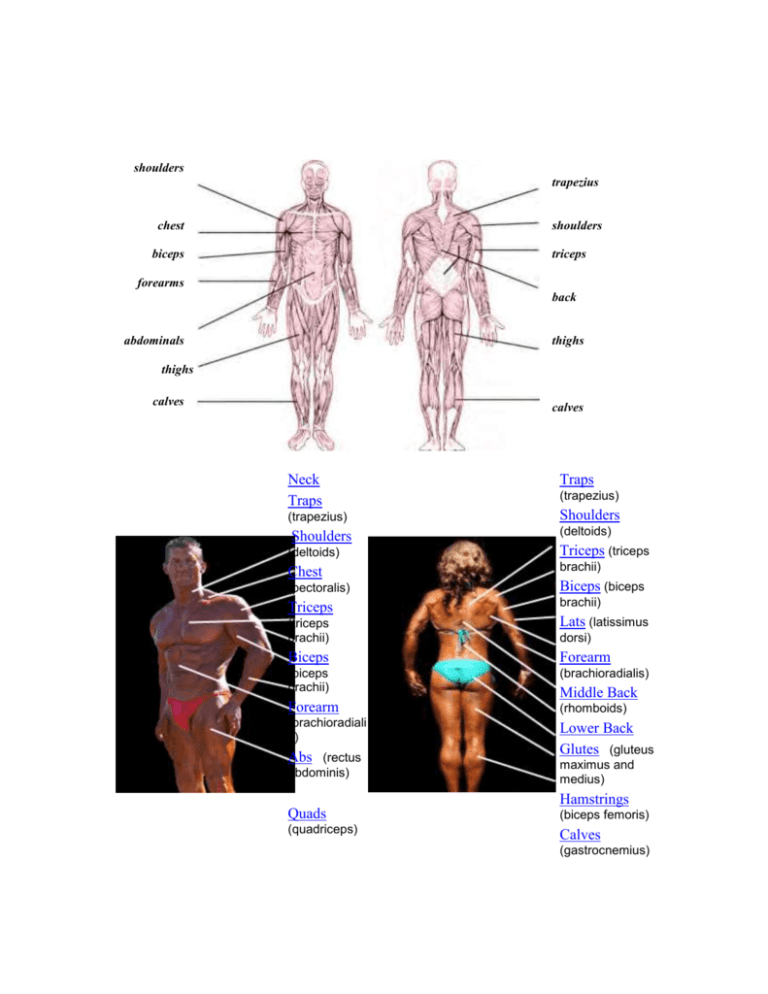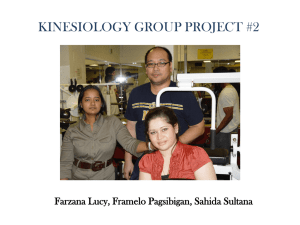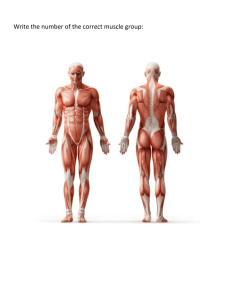Muscle Chart - Inspired by Julie Personal Training
advertisement

shoulders trapezius chest shoulders biceps triceps forearms back abdominals thighs thighs calves calves Neck Traps Traps (trapezius) Shoulders Shoulders (deltoids) (deltoids) Triceps (triceps Chest brachii) (pectoralis) Biceps (biceps Triceps brachii) (triceps brachii) Lats (latissimus Biceps Forearm (biceps brachii) (brachioradialis) Forearm (rhomboids) (brachioradiali s) Lower Back Glutes (gluteus Abs (rectus abdominis) (trapezius) dorsi) Middle Back maximus and medius) Hamstrings Quads (biceps femoris) (quadriceps) Calves (gastrocnemius) MUSCLES AND MUSCLE GROUPS LEGS Your legs contain some of the largest muscles in your body. For the purpose of weightlifting, most experts divide the legs into four separate muscle groups: quadriceps, hamstrings, gastrocnemius (calves), and anterior tibialis. The quadriceps and hamstrings act at the knee joint and the gastrocnemius and anterior tibialis act at the ankle joint. Quadriceps: The large group of muscles on the front of the upper leg, often referred to as the thighs. Your quadriceps are so named because they are a group of four (quad = four) different muscles: the rectus femoris, vastus lateralis, vastus medialis, and vastus intermedialis. The quadriceps run along the front of the thigh, starting at the hip joint and ending at the knee joint. The quadriceps' primary function is to flex the hip and extend the knee, very important in walking, running, jumping, climbing, and pedaling. Hamstrings: The group of muscles on the back side of the leg, running from the hip joint to the knee joint. The hamstrings are a group of three muscles: biceps femoris, semimembranosus, and semitendinosus. The hamstrings' primary function is to facilitate flexion of the leg, and medial and lateral rotation, which is important in activities such as jumping, pedaling, walking, and running. Gastrocnemuis: Groups of muscles farther down the back of the leg running from the backside of the knee to the Achilles tendon. The two muscles that make up the calves are the gastrocnemius and soleus. Their primary function is to extend your foot at the ankle and flex your toes, which helps you jump, walk/run, and pedal. Anterior Tibialis: The small muscle group on the front side of your lower leg which runs along your shins. The anterior tibialis, like the calf, helps you run and jump, and functions to flex your foot upward. BACK Your back is characterized by three smaller muscles: latisimus dorsi, rhomboids (upper/middle back), and lumbo dorsi or erector spinae (lower back). These three muscles, along with smaller supporting muscles deep beneath the skin's surface, play a huge role in almost everything you do, from swinging a golf club to sitting at the dinner table. Latisimus Dorsi: Run along the sides of your back and are most commonly called lats. Your lats help you extend, rotate, and pull your arms to your body (adduction), important in pulling activities such as rock climbing and rowing. Rhomboids (Major and Minor): Compact muscles located a few inches down from the neck, between the spine and shoulder blades, referred to as the upper/middle back. The rhomboids' primary function is to retract, elevate and rotate the shoulder blades, which also helps you accomplish pulling activities such as starting a lawn mower or serving a tennis ball. Lumbo Dorsi (Erector Spinae): Runs along the lower part of the spine, hereafter referred to as the lower back. Your lower back supports your upper body, extending your spine and flexing it to either side, a part of almost every activity imaginable. DELTOIDS AND TRAPEZIUS Deltoids: There are three specific areas of your shoulders: anterior (front), lateral (side), and posterior (rear)--each gets specific attention from various shoulder exercises. The front shoulders flex and medially (inwardly) rotate the arm. The side shoulders abduct the arm (moves it away from the body). The rear shoulders extend the arm and cause lateral (outward) rotation. These functions of the shoulder muscles help in performing throwing and swinging activities such as pitching, passing, climbing, and racquet sports. Trapezius: Many shoulder exercises also work the trapezius muscle. This muscle slopes down the side of your neck from the base of your skull to the upper part of your back. The trapezius muscle raises your shoulders and rotates your shoulder blades, and is helpful in lifting activities, such as moving furniture. TRICEPS The triceps are muscles that run on the back side of your upper arm, from your shoulder to your elbow. Your triceps have three "heads," or small sections that make up the entire muscle group; they constitute almost two-thirds of your upper arm. The triceps' primary function is to extend the elbow. This is helpful in shooting a basketball and throwing or passing a ball BICEPS What people commonly refer to as the biceps are actually two distinct muscles: the biceps brachii and the brachialis. Both muscles run along the front of the upper arm, from the shoulder to the elbow. The biceps brachii is responsible for the balllike "head" on your biceps; the brachalis is the larger of the two, located underneath the biceps brachii. Both muscles that make up the biceps help flex your elbow. In addition, the biceps brachii helps to supinate your forearm. This is very helpful in swinging a racquet in sports like racquetball and tennis. FOREARMS The forearms are the muscles between the elbow and the wrist. The forearms consist of three smaller muscle groups: brachioradialis, flexors, and extensors' The brachioradialis and extensors make up the front part of the forearms and help to extend or move the back of your hand toward your forearm; they also help to extend your fingers. Your flexors make up the back or underside (inner part) of your forearms; they flex or move your palm toward your forearm and help to move your fingers. Your forearms control most of your gripping strength and help with activities like swinging a golf club or baseball bat, throwing a ball or climbing; your forearms also help with fine motor skills such as drawing or playing a piano. CHEST The chest muscles are made up of the pectoralis major and the pectoralis minor. The pectoralis major is the bigger of the two and spans most of the clavicle and sternum and attaches to the upper arm. It has several important functions at the shoulder: flexion, adduction (towards body), and medial (inward) rotation. The pectoralis minor is a thin triangular muscle that lies beneath the pectoralis major and is responsible for similar functions. Your chest is helpful in contact sports that require a lot of pushing such as football and rugby. ABDOMINALS Your abdominals, commonly called abs, consist of several muscle groups, all located in the midsection, just below your chest to your pubic bone. These include: rectus abdominis which is made up of upper, middle, and lower abs; transverse abdominis; and the obliques. The upper, middle and lower abs start near the middle of your sternum and runs vertically to the lower part of the pelvis; they are responsible for flexing the vertebral column or helping you curl your trunk as you would when doing crunches or sitting up in bed. The transverse abdominal muscles run horizontally and are the deepest muscular layer of the abs; they run around your body like a girdle and help compress and support internal organs. The obliques are the muscles that make up your waist and consist of two smaller groups: the external obliques and the internal obliques. The external obliques are the muscles of the upper and outside part of your waistline; they start just under your chest, on your lower eight ribs, and are responsible for helping you twist and bend sideways. The internal obliques are located beneath the external obliques; they also helps you twist. It is important to have strong abdominals for most all motions, including common day-today activities. In addition, most low-back pain is attributed to weak abdominals. BUTTOCKS There are three muscles that make-up your buttocks: gluteus maximus, gluteus medius, and gluteus minimus. The gluteus maximus is the biggest and most noticeable of the three. The medius and minimus aren't as noticeable--both are located around your ilium, the large bony part of the pelvis. Together these three muscles help you move your thigh out to the side of your body (abduction), as well as rotate and extend your leg behind you. A strong buttocks helps in most all explosive/power activities, such as football, basketball, and hiking. A big thing to remember is that your muscles don't grow in the gym, they grow when you rest and take in adequate protein. When you lift weights, you rip apart the muscle fibers and your muscles fix themselves to be stronger. You rip them up in the gym, but they don't fix themselves to be stronger until you rest, so if you don't rest, you won't get stronger. In terms of rest, most major muscle groups take about 48h to recover. Your calves and forearms are used all the time for anything that involves you moving something in your hand, or walking around, so they are used to a lot of activity, so they recover faster, and have more endurance. With that in mind, the most effective training routine includes full body routines and splitting up your muscle. Unlike most things you are taught, "less is more" in weight training. Make sure you rest and get adequate protein.






